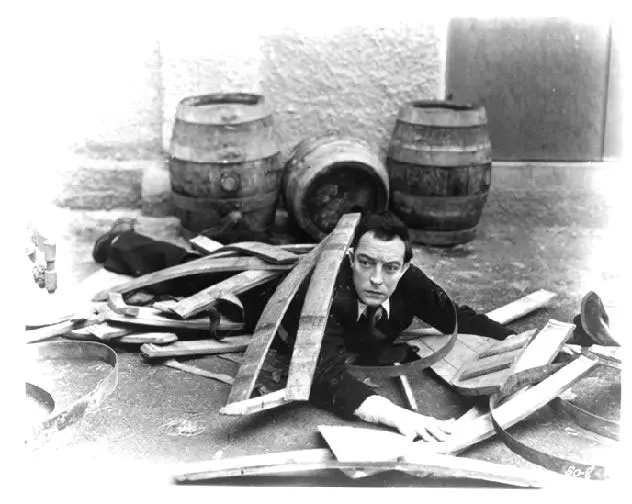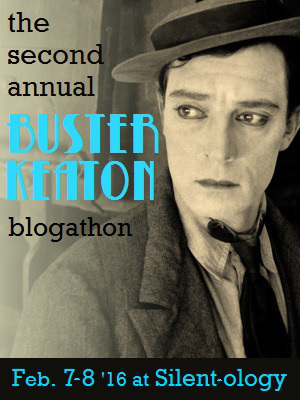Remember: If it bends, it?s funny. If it breaks, it isn?t. ?Lester (Alan Alda),?Crimes and Misdemeanors
There was nothing funny about it when Buster Keaton broke.
Keaton?s fall is legendary. Most of the time it?s told sketchily, and too often as if it were the end.?As I learn more about the actors in classic movies, I am increasingly saddened to find out how many of them foundered and came to tragic ends, frequently at least partly via addiction of one kind or another.
Buster?s fall was huge and heartbreaking, but it wasn?t the end. While the world of filmmaking in which he flourished had vanished, and he bore the wounds and scars of his years of heavy drinking, Buster Keaton kept on getting up.

No fall or stunt Keaton ever did in any of his movies matched the one he managed in effecting not only his own survival, but eventually salvaging his personal life by marrying happily and for keeps, and reconnecting with his grown sons and spending precious time with his grandchildren. And in the decade and a half before his death in 1966 he was rehabilitated professionally and artistically, too, and he saw his films (the ones he had believed lost) screened for adoring audiences at festivals and museums in the U.S. and Europe. ?Forty years too late,? said Buster, but it has to have been sweet vindication.
And he never really went away. Except for a few periods in the mid-?30s when his drinking was completely out of control, Keaton worked. He made films in Europe. He made shorts for Educational and Columbia. He worked as a gag man for a fraction of what he used to earn when he was a star, and he played small character parts and did television and made commercials?
Well yes, says conventional wisdom. But a lot of this stuff wasn?t any good, and he never again directed a film or appeared in one as great as his features of the 1920s.
Granted. It?s also true not only of almost all the stars of the silent era, it?s true of Harold Lloyd as well. Only Chaplin managed to hold back the hands of time and make two more great silent features in the ?30s before finally succumbing to sound with?The Great Dictator, his first real talkie, in 1940.

Speak Easily (1932), with Thelma Todd
I think the carping says more about us than it does about Keaton. We feel cheated. We?re disappointed not to have more of him, and his alcoholism and lack of business acumen, not to mention some poor decisions, make it easy to pretend that if he had been stronger and made better choices he could have gone on turning out brilliant comedies despite all evidence to the contrary. Bu it?s not possible to understand Keaton?s fall without placing?it within the context of the huge changes that were transforming the movie industry.
I wish as ardently as anyone that we had a few more Keaton masterworks. But perhaps we should grow up and be happy for what we have. Buster took enough of a beating in his life. He doesn?t need his fans to keep whaling on him 50 years after his death.
We love the falls. We suck up stories of great falls like human paper towels. What?s that about? We seem to delight in the grisliest details about Whitney Houston or Michael Jackson.?I?ve wondered for a long time, and I still don?t have an answer. And I have to admit that I have wallowed in the details of Robin Williams?s and Philip Seymour Hoffman?s final hours along with the rest of the social media commentariat. I admit it, but I?m not proud.
Oddly, we seem to love the falls even of artists we hold in the highest regard, people we admire, respect, and feel the greatest affection for.
The story of Buster?s professional and personal collapse has been told countless times and it?s generally repeated without examining or questioning the main points. It usually goes something like this:
Buster Keaton was a genius, but he singlehandedly destroyed himself and his career. He could only make silent films, so when sound came he fell apart. He drank and philandered his marriage to death, then got fired by Louis B. Mayer, and never made another great movie. He was reduced to working as a $100-a-week gag man at MGM, recycling his own gags for the Marx Bros and Red Skelton. He did a?Twilight Zone?episode and appeared in a few movies in small parts, the last being?A Funny Thing Happened on the Way to the Forum?in 1966, which was completed just before he died of lung cancer at the age of 70. THE END.

The final image of Cops (1921), a shot that has launched a thousand film studies theses?
A few writers as far back as Thom Dardis in his biography?Keaton: The Man Who Wouldn?t Lie Down,?and as recently as Imogen Sara Smith in her invaluable 2008?Buster Keaton: The Persistence of Comedy, have challenged this narrative by filling in the specifics of both the collapse and the more than 30 years that followed. Keaton seems to be undergoing a critical rethink, which is long overdue. But?the story just refuses to die.
First, to clarify: That Keaton?s life unraveled completely in the early ?30s is undeniable. That his alcoholism, which seems to have been held in trust for him by his dad, Joe, was a huge factor in the collapse is also indisputable.
But!?but. First of all, often there?s a judgmental quality in the narrative that?s peculiar in our day, when. most of us understand that addiction isn?t about weak character, and it?s certainly not about choice.
Here?s what Buster wrote about it in 1959:
?You are all right as long as you can drink and wake up without a hangover. You are still all right if you can fight off the tearing desire for an eye-opener?that eye-opener that brings such relief but doesn?t last long enough, and leads you into taking another and another until you find yourself waking up with a hangover all over again?. Keep it up a while and whenever a couple of little things go wrong, you find yourself saying the hell with it and getting drunk to help you forget. And that?s the final step that brings you to the police station or the psychopathic ward.?
It?s so painful to look at photos of Buster in the early ?30s, to see his extraordinary face, one of the most beautiful ever photographed, grow haggard and gaunt, to see the pain and darkness in his eyes.
I?ve not found any source on when Buster?s drinking crossed the boundary between manageable partying to alcoholism, when the hangovers started and then the eye-openers. In the 1920s, during Prohibition, as you know, a lot of people were doing a whole lot of drinking?drinking and speculating in the stock market were the national pastimes. Drinking hard was considered normal. Not drinking indicated that you were a prig, a stick in the mud.
If Buster?s alcoholism is put forth as the cornerstone of his fall, it rests on some faulty assumptions. Such as, that had he not become a drunk he could have continued to make films as he had in the ?20s when he had his own studio and total creative control.
Truth is, the movie industry was undergoing transformation throughout the late ?20s as the studios consolidated power and adapted assembly-line methods to film production. Keaton had been able to work as an independent, hence his control over his work. The studio era effectively removed that option. Had?The General?and?Steamboat Bill, Jr.?been more successful at the box office, perhaps Keaton could have made one or two more films his way, but he would only have succeeded in forestalling the inevitable.

Speak Easily (1932)
Then there?s sound?was Keaton incapable of making the transition? Quite the contrary: He was eager to make his first talkie. Keaton was never afraid of new technology?he was an early adopter. And we know from his subsequent work that his voice was suitable and that his delivery and timing were excellent. But it wasn?t up to him. By that time he was at MGM, where his old producer/father figure, Joe Schenck, had set?him up when Schenck decided to close Keaton?s studio and concentrate on running United Artists in New York.
Chaplin and Lloyd had both counseled Keaton against the move to MGM, but Keaton trusted Schenck?s assurances that he would continue to have creative control. After making the move it became clear that Metro totally misunderstood Keaton?s character. The studio pigeonholed him as a Sad Clown. Similarly, they would years later almost destroy Frank Sinatra?s screen career by pigeonholing him as the shy little guy who was afraid of girls. Imagine?Sinatra afraid of women.

Free and Easy (1930): Keaton as Sad Clown, a total misread of his character.
Keaton first MGM feature,?The Cameraman, is a delight and the last he ever made with his handpicked creative team. The studio replaced them with New York dialogue writers that they felt Keaton needed in the new environment of talkies. But Keaton was horrified?everything he knew about himself, his character, and how he worked was being undermined, and to compound his frustration the movies he made at Metro were more profitable than some of his best work. But then Keaton had always gone over some critics? heads: At least one review of?Sherlock, Jr.?had complained that it wasn?t original enough, which is incomprehensible?what did it remind them of? And?The General, widely seen today as one of the greatest movies ever made in Hollywood, was upon its original release a critical and commercial flop.

The Cameraman (1928), the last great Keaton film and the last time Buster had creative control

It might have been anywhere in this rolling nightmare that he crossed the hangover-eye-opener line. And there were more horrors to come. MGM couldn?t afford to let their new asset risk serious injury by doing his own stunts, so Buster, to his disgust, saw the stunts he had done his entire life farmed out to a stuntman. Then some genius at Metro decided to team Keaton, who was a paradox of ferocious action and deep stillness (?Think slowly, act quickly,? he said), with Jimmy Durante, the Schnozzola, a New York nightclub comic turned movie star in the early sound era.

The Schnozzola, Jimmy Durante. It?s hard to think of a worse partner for Keaton.
The combination of tight scripting and a partner whose style was all noise and cheerful vulgarity stranded Buster with no space in which to work. It extinguished him. You can see it in his scenes with Durante. Buster?s effortlessly dominant presence has gone flat.

Watching everything he had worked for in his film career disintegrate? In an interview in the ?50s Buster talks disdainfully about working with the Marx Bros and Abbott and Costello, who did no preparation and just showed up on set to shoot whatever had been written for them. He says, with some heat, that ?when we made pictures we ate, slept, and dreamed them.? Now he was MGM?s creature, a cog in a huge wheel. But he needed the money, badly. Possibly if he had been able to go home to love and support he might not have lost himself so completely, he would have had an identity to hang onto. Unfortunately?his marriage to Natalie seems never to have provided him safe harbor, and as his artistic and professional life eroded he lost his precarious status at home, too.

Keaton is depicted as extremely passive in terms of managing his career as well as his divorce. I cannot say otherwise, having seen almost no evidence to the contrary, but it does seem ironic that Keaton, who embodied movement and action, should be in other areas of life almost a spectator.
If it?s true, it might be one of those terrible webs of temperament and circumstance. Buster had never worked as anything but a performer, first onstage and then on film. He had almost no formal education. His remarkable intelligence is obvious not only in the conception of those impossible gags but in figuring out how to execute them. And it?s not just the gags but his brilliant direction that we respond to today.?Keaton said that had he not been in show business he might have become an engineer, and Keaton devotees won?t find that surprising.

Perhaps he lacked interest in financial matters or lacked the confidence to tackle them. As long as there was a lot of money coming in all was jake. Buster was totally?focused on making movies, and he trusted Joe Schenck to manage the financial stuff and the dealmaking. Still, even at his earning peak Natalie sure could spend it faster than he could make it. I will never understand why the Italian Villa, the palace he built for her, was in her name rather than his, so that when the marriage went bust he got nothing. He seems to have owned almost nothing of his own. Thank God he had bought his mother a large house; later, he and Eleanor were able to move in there with Myra and Keaton?s brother and sister, whom Buster supported even in his hardest times.
Also, Keaton honorably discharged the debts he had racked up during his dark days, even though his earnings were a fraction of what they were in the old days. He worked diligently and did the right thing. A lot of people who had lost their work, their health, and not just their marriage but their children?Natalie not only won full custody but changed the boys? last name from Keaton to Talmadge, which seems unimaginably cruel as well as pointless?would have crashed and burned?and never gotten back up. But not Buster.

Buster had never before faced real failure; he had always been a success. Throughout his childhood and teen years, the only time?he was without work for any extended period was when he had broken up?The Four Keatons (largely in response to his father?s increasing disability from his own alcoholism) and was hanging around New York waiting to find something new?which he did when he visited his pal Roscoe Arbuckle on the set and was so fascinated with the camera. Then he went into films and for the next 11 years he was a star. Buster had never had to deal with not being wanted, and never before as an adult to deal with debt and dwindling work and funds. Had he owned his own films as Chaplin and Lloyd did, it wouldn?t have translated into ready cash; he still would have had to take whatever work he could get to keep up with the bills.
Here is where we owe Buster some respect. It must have been unspeakably painful to be involved with films that were mostly cheap and shoddy. But he had debts and his family to take care of, and he had the humility and inner strength to honor those commitments.

Buster and Eleanor, the third and final Mrs. Keaton
It?s a good thing he did keep getting up, because Buster?s luck did come back, and he was able to make the most of it. A pivotal year was 1940, when his now-grown sons came back into his life. Meeting Eleanor Norris, a Metro contract dancer 24 years his junior, was a huge stroke of luck, too. They married in 1940, though friends were appalled by their age difference, and their union lasted until Buster?s death 26 years later. Winning the heart of a very attractive young woman must have gone a long way toward repairing Buster?s busted confidence. A few years later he and Eleanor began performing together and in 1947 they began their series of appearances at Cirque Medrano in Paris. This began Buster?s climb back to artistic solvency. James Agee?s famous 1949 LIFE Magazine essay, ?Comedy?s Greatest Era,? also helped, by introducing Keaton to a new generation. The Medrano shows led first to more engagements with Eleanor in Italy, England, and Scotland; then, thanks to a suggestion by Harold Lloyd, Buster got?his own TV show in Los Angeles for a few months, and that opened the door to more film work as well as national TV appearances and commercials.

Buster and Eleanor
In 1950 Buster was able to walk away from his gag writing job at MGM?he no longer needed the money. In the next few years some of his films, which he had thought lost, were found in his old projection room at the Italian Villa by James Mason, who was now the owner. Mason came across dozens of cans of film that turned out to be positives in good condition. Around that time it turned out that MGM also had a number of Keaton?s films in their vaults, and renewed interest in the films came just in time: The nitrate stock was deteriorating quickly, and another year might have been too late.

The Keatons at home at ?the ranch?
Buster bought an acre and a half in the San Fernando Valley, and he and Eleanor set up housekeeping. In 1940, the same year he and Eleanor had married, his sons came back into his life, and so his family, always so important to Keaton, was eventually restored.
Tragedies end in death; comedies end with new life. Buster Keaton survived his own terrible smash-up and first crawled away from the wreckage, then walked, and finally walked a few inches off the ground. He was happily married; his sons were part of his family again; and his greatest work found new audiences who perhaps appreciated his films more than the?original audiences had.

with granddaughter Melissa
I call that a happy ending.




Thank you! I enjoyed reading this very much.